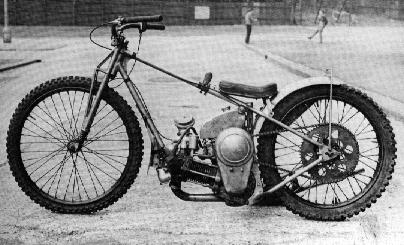



THE J.A.P - Chapter 4.
For the 1933 season, further engine design changes were made with the twofold objective of improving engine performance whilst at the same time retaining a high degree of reliability.
One problem that arose as a result of these modifications was a tendency for the cylinder head joint to blow in the area between the exhaust port outlet and the exhaust valve seat. The cylinder head casting was somewhat shallow at this point, so that warping was prone to occur when the head was tightened down. A permanent cure was devised in time for the 1935 season by modifying the basic engine design to accommodate five cylinder head holding studs in place of the four used previously - the advent of the so-called '5 stud JAP'.

One of these studs was located exactly in the area that had been giving trouble. Other internal changes took place during the years that followed, mostly of a minor nature, so that the engine remained virtually unchanged until the Second World War brought a temporary end to production. In 1935/6 duralumin connecting rods were used, until a spate of breakages with consequent severe engine damage necessitated reversion to the original steel specification. The rotary breather used in the production engines was dispensed with at the end of the 1933 season and soon after, the design of the shock absorber in the primary drive was changed to the splined arrangement found on all later engines. There was also an attempt to dispense with the use of tapered shafts, using instead parallel shafts fitted with keyways, until fresh problems made it necessary to return to the tried and proven practice of the past. It was a modification made in 1934 by Wal Phillips that eventually followed on the production engines - the use of valve caps to enclose the valve springs. Initially they were not attached direct to the rocker box assembly, but it seems probable this final modification was made around 1936.
After the war, the cast iron cylinder head was recast, with more metal in the area close to the exhaust port where earlier leakage problems had been experienced. In consequence, engine design could now revert to the original four-stud arrangement, whilst retaining the longer connecting rod and cylinder barrel. The first few of the new four-stud engines appeared during 1947, but the change-over was not fully implemented until the 1949 season, some engines having a form of conversion. During the early fifties the 4A engine came into being, which used an Alfin aluminium alloy cylinder barrel. Initially, these cylinder barrels caused problems, as subsequent tests showed their bore was prone to distort as much as 0.004 inch out of true' when the cylinder head was tightened down. A slightly thicker wall casting soon cured this.

Some cylinder barrels were made with more generous finning, these being for use on engines that were being fitted into Formula 3 racing cars. It had been found that a speedway JAP engine could more or less rival the performance of a dohc Norton engine, the latter being much more difficult to obtain and certainly more expensive to run and maintain.
The final stages in the development of the speedway JAP engine took place after the Tottenham factory had faced hard times and been forced to merge with the Villiers Engineering Company during 1957. Alec Jackson, a former speedway rider, had acquired the manufacturing rights in 1951 and continued to hand-build the engines and supply spares for many years afterwards, and later still, George Greenwood. A new design of cam helped boost engine performance still further and when the Ama1 Track Racing Carburetter went out of production, the 4B engine emerged in 1967 which had a bigger inlet port to accept the new Amal 932 Concentric carburetter that had taken its place. It represented the last in the long line of speedway engines that had a direct link with the original manufacturer.
A few variations, such as the Cole JAP, the four-valve Luckhurst conversion and even a four-valve dohc design lingered on, but were not successful in keeping the old engine alive. Modern technology had caught up with it at last and it became an inescapable fact that the more modern generation of engines originating from Czechoslovakia were easier to ride on account of their smoother power output and, more to the point, did not require attention anything like so frequently between race meetings.